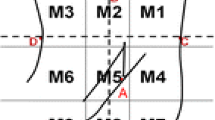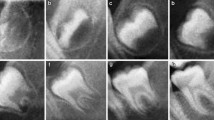Abstract
Aim
To elucidate intra- and inter-maxillary patterns of second premolar agenesis in the mandible and maxilla—including unilateral and/or bilateral occurrence and gender differences.
Study design
The study comprised panoramic radiographs from 4,756 children with and without orthodontic treatment needs.
Methods
All radiographs were screened twice. 251 individuals had agenesis of one or more mandibular and/or maxillary second premolars; 37 had agenesis of both mandibular and maxillary second premolars.
Statistics
Gender differences were analysed using χ² and Fisher’s exact test.
Results
193 individuals had agenesis of one or both mandibular second premolars, while 95 had agenesis of one or both maxillary second premolars. In females, agenesis of left and right second premolars was significantly associated in both the mandible and in maxilla (p < 0.0001). In males, this association was only significant in the maxilla (p < 0.0001). Bilateral agenesis occurred almost twice as frequently in females. Unilateral agenesis in the maxilla occurred almost twice as frequently in females. The probability of finding second premolar agenesis in the maxilla was significantly greater in females than in males (p = 0.03). A significant association was seen between agenesis of tooth 25 and 35 in females and males combined (p = 0.03) and in males alone (p = 0.01). No significance was found between agenesis of tooth 15 and 45 in either females or males.
Conclusions
The study confirms some previous findings of second premolar agenesis and presents new observations on gender differences, especially concerning associations in agenesis occurrence within and between the jaws.


Similar content being viewed by others
References
Baccetti T. A controlled study of associated dental anomalies. Angle Orthod. 1998;68:267–74.
Chavéz-Lomelí ME, Mansilla LJ, Pompa JA, Kjær I. The human mandibular canal arises from three separate canals innervating different tooth groups. J Dent Res. 1996;75:1540–4.
Daugaard S, Christensen IJ, Kjær I. Delayed dental maturity in dentitions with agenesis of mandibular second premolars. Orthod Craniofac Res. 2010;13:191–6.
Demirjian A, Goldstein H, Tanner JM. A new system of dental age assessment. Hum Biol. 1973;45:211–27.
Garib DG, Peck S, Gomes SC. Increased occurrence of dental anomalies associated with second-premolar agenesis. Angle Orthod. 2009;79:436–41.
Haavikko K. The formation and the alveolar and clinical eruption of the permanent teeth. An orthopantomographic study. Suom Hammaslääk Toim. 1970;66:103–70.
Jernvall J, Thesleff I. Reiterative signaling and patterning during mammalian tooth morphogenesis. Mech Dev. 2000;92:19–29.
Kelly KA, Wei Y, Mikawa T. Cell death along the embryo midline regulates left-right sidedness. Dev Dyn. 2002;224:238–44.
Kenrad AB, Christensen IJ, Kjær I. Craniofacial morphology of the frontonasal segment in patients with one or two macrodontic central incisors. Eur J Orthod. 2012 [Epub ahead of print].
Kjær I. Neuro-osteology. Crit Rev Oral Biol Med. 1998a;9:224–44.
Kjær I. Prenatal traces of aberrant neurofacial growth. Acta Odontol Scand. 1998b;56:326–30.
Kjær I. New diagnostics of the dentition on panoramic radiographs-Focusing on the peripheral nervous system as an important aetiological factor behind dental anomalies. Orthodontic Waves. 2012;71:1–16.
Kjær I, Nolting D. Immunohistochemical PGP 9.5 positivity in human osteoblasts may indicate that compensatory and dysplastic craniofacial growth are under control by peripheral nerves. Orthod Craniofac Res. 2008;11:196–200.
Kjær I, Kocsis G, Nodal M, Christensen LR. Aetiological aspects of mandibular tooth agenesis—focusing on the role of nerve, oral mucosa, and supporting tissues. Eur J Orthod. 1994;16:371–5.
Levin M. The embryonic origins of left-right asymmetry. Crit Rev Oral Biol Med. 2004;15:197–206.
Luukko K, Kvinnsland IH, Kettunen P. Tissue interactions in the regulation of axon pathfinding during tooth morphogenesis. Dev Dyn. 2005;234:482–8.
Luukko K, Moe K, Sijaona A, Furmanek T, Hals KI, Midtbø M, Kettunen P. Secondary induction and the development of tooth nerve supply. Ann Anat. 2008;190:178–87.
McSherry PF. The ectopic maxillary canine: a review. Br J Orthod. 1998;25:209–16.
Peck L, Peck S, Attia Y. Maxillary canine-first premolar transposition, associated dental anomalies and genetic basis. Angle Orthod. 1993;63:99–109.
Peck S, Peck L, Kataja M. The palatally displaced canine as a dental anomaly of genetic origin. Angle Orthod. 1994;64:249–56.
Peck S, Peck L, Kataja M. Prevalence of tooth agenesis and peg-shaped maxillary lateral incisor associated with palatally displaced canine (PDC) anomaly. Am J Orthod Dentofac Orthop. 1996;110:441–3.
Polder BJ, Van’t Hof MA, Van der Linden FP, Kuijpers-Jagtman AM. A meta-analysis of the prevalence of dental agenesis of permanent teeth. Community Dent Oral Epidemiol. 2004;32:217–26.
Ringqvist M, Thilander B. The frequency of hypodontia in an orthodontic material. Sven Tandläk Tidskr. 1969;62:535–41.
Rune B, Sarnäs KV. Tooth size and tooth formation in children with advanced hypodontia. Angle Orthod. 1974;44:316–21.
Rølling S. Hypodontia of permanent teeth in Danish schoolchildren. Scand J Dent Res. 1980;88:365–9.
Rølling S, Poulsen S. Agenesis of permanent teeth in 8138 Danish schoolchildren: prevalence and intra-oral distribution according to gender. Int J Paediatr Dent. 2009;19:172–5.
Sørensen HB, Artmann L, Larsen HJ, Kjær I. Radiographic assessment of dental anomalies in patients with ectopic maxillary canines. Int J Paediatr Dent. 2009;19:108–14.
Tabatabaie F, Sonnesen L, Kjær I. The neurocranial and craniofacial morphology in children with solitary medianmaxially central incisor (SMMCI). Orthod Craniofac Res. 2008;11:96–104.
Uslenghi S, Liversidge HM, Wong FS. A radiographic study of tooth development in hypodontia. Arch Oral Biol. 2006;51:129–33.
Acknowledgments
Maria Kvetny, MA, is acknowledged for linguistic support and manuscript preparation. The IMK Foundation is acknowledged for funding.
Author information
Authors and Affiliations
Corresponding author
Rights and permissions
About this article
Cite this article
Kenrad, J.B., Christensen, I.J. & Kjær, I. Gender differences in patterns of second premolar agenesis observed in 4,756 individuals. Eur Arch Paediatr Dent 14, 397–403 (2013). https://doi.org/10.1007/s40368-013-0041-8
Received:
Accepted:
Published:
Issue Date:
DOI: https://doi.org/10.1007/s40368-013-0041-8




